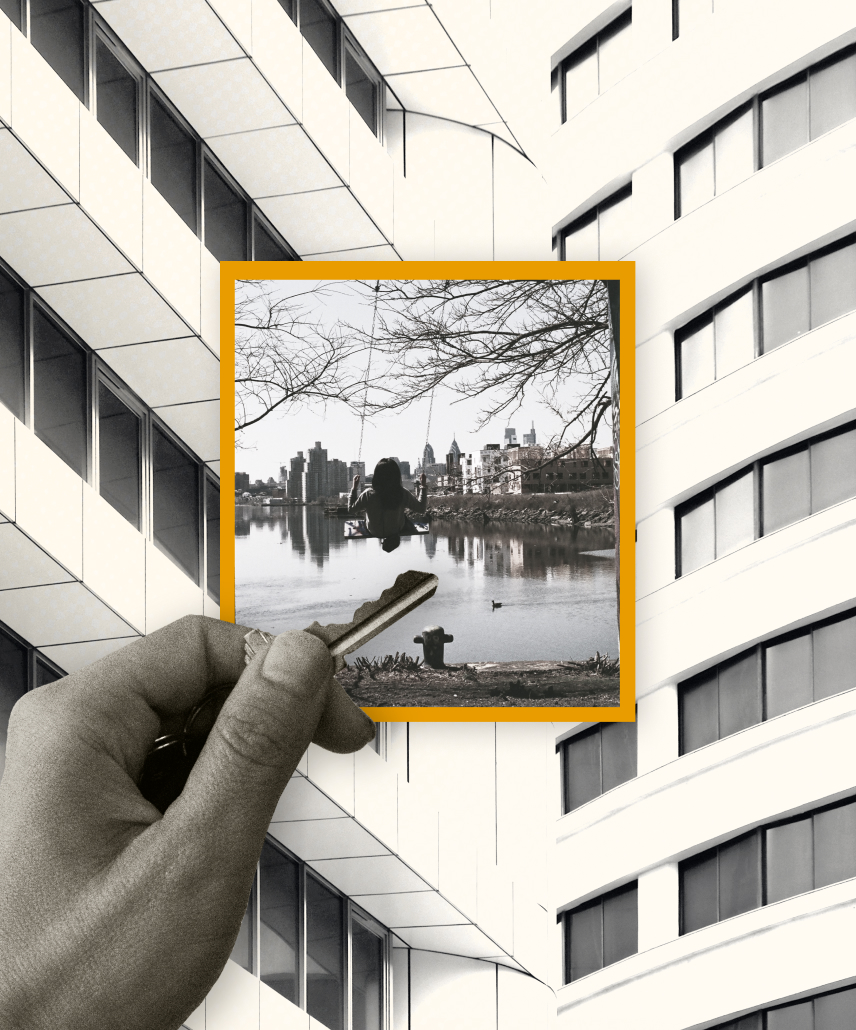The Power of Place: Reclaiming Vacant Lots, Corner Stores, and Whole Blocks for BIPOC Communities.
Authors: Melonie Tharpe, Former Director Portfolio Initiatives


When we look at the racial wealth gap—both in the context of where wealth has traditionally been built in the U.S., and where capital and power have been stripped from BIPOC communities over generations—it’s clear that place has immense power over the circumstances and outcomes that affect our community and our personhood.
Owning land is still seen as part of the storied American dream. But when that dream did not include Black, Indigenous, or other communities of color, they built a dream all their own.
Without access to essential needs and services, communities survive by sharing what they have and rebuilding what they lost. In the US, BIPOC communities have made economic institutions of the houses of worship, barbershops, strip malls, and corner stores that bring their neighborhoods to life. Sociologists have coined these spaces as third places, and they essentially serve to meet people where they are.
And while BIPOC communities still face a disproportionate amount of environmental harm, including the lasting legacy of redlining, these once affordable neighborhoods have seen rising costs in part due to gentrification, remote work migrations, and the rise of commuter communities. What’s more, those families—for whom these neighborhoods are home—face displacement, or are forced to pay a premium to stay, despite the cyclical systemic failures they’ve been subjected to. BIPOC communities need alternative sources of support now more than ever.
Enter: place-based investing, which would help fill crucial gaps in the system, and give communities the freedom to build local economies without further extraction. There, people can get trusted care, find jobs using cooperative funding models, join mutual aid networks, find connections to affordable housing, or access health education and services. Our surroundings shape so much of who we become. Even when we build a community someplace new, we are always tied to the street we grew up on.
However, as more institutions build the muscle for equitable investing and trust-based philanthropy, the availability of financial support from an institution communities can trust won’t be nearly as scarce—a scarcity that is predicated by a long history of policies that still reinforces the harmful narrative that investing in Black and Brown communities is “risky”. The dangerous message this sends is that Black, Indigenous, and people of color in general are unsafe, untrustworthy, and undeserving of opportunity, safety, and belonging.
The real power of place is felt not just in where someone lives, but how and if. When we invest in place, communities are equipped with more tools to thrive (not just survive).
The truth is, we can have an economy that’s centered around belonging. The conditions for change are already here. We have enough for everyone and we even have room to grow—without pushing anyone out.
To protect our progress and move towards our shared future, we must invest abundantly in the solutions and ideas that are most likely to get us there.
Last year, Common Future set out to learn from local leaders working in BIPOC communities engaging in commercial and mixed-use real estate projects from across the US and explore how they navigate community impact.
We were honored to spend time with organizations that are challenging the status quo by reclaiming vacant lots, corner shops, and neighborhood blocks, and ensuring that Black, Indigenous, and other people of color will share power, choice, and ownership over their own economic future.
LOS ANGELES
In Los Angeles, nonprofit Little Tokyo Service Center is leveraging its decades of experience in providing affordable housing for the Japanese-American community to buy, revitalize, and make affordable the business spaces that its community relies on. They have also used those lessons to bolster the efforts of neighboring communities, partnering with Inclusive Action for the City in buying and renovating a building to sell back to the community.
CHICAGO
In Chicago, a group of small business entrepreneurs experienced the lack of turn-key affordable spaces in the city’s Black neighborhoods. They formed EG Wood, an L3C social business, and are reactivating underused commercial spaces with re-designs and upgrades that fit the needs of local businesses.
CLEVELAND
In East Cleveland, nonprofit Loiter is working to build an entire local business ecosystem by buying up commercial spaces, vacant lots, and even wholesale businesses.
NEW YORK + PHILADELPHIA
In NYC and Philadelphia, for-profit Urbane has years of experience building out spaces for BIPOC businesses and currently redevelops commercial blocks as community anchors, working with existing businesses who need assistance improving or even buying their spaces.
Also in Philadelphia Kensington Corridor Trust is leveraging a newer neighborhood trust model, working under community direction to buy and transform mixed-use and vacant properties across an entire neighborhood.
These community efforts are a testament to the work being done to close the widening gap of wealth disparity in communities that have historically been left out of property ownership. We are furthering our commitment in two ways: 1. Investing our own resources in commercial and other real estate projects and 2. Open-sourcing what we learned about how these projects create impact for the right kind of investors and communities alike.
More impact investors and philanthropic groups need to take big bets on projects that take a holistic approach to the economic needs of a community—shifting power and control of neighborhoods to those who live and work there. Since these projects can seem complicated from the outside, mixing legal structures, layering financing options, and utilizing a wide range of programs to increase the impact of their projects, we want to ensure funders have a better understanding of why these projects are built the way they are and exactly how their investments will impact the communities they serve.
We are challenging funders to join us in learning about
and investing in wealth-building commercial real estate
projects with our new report.
We’ve open-sourced what we learned about how these projects create impact for the right kind of investors and communities alike and are sharing these lessons in the hopes it can move more investors into this space.
In addition to the numerous systemic and finance issues encountered by BIPOC real estate developers as covered in the ICC Black Paper, developers and organizations focused on community ownership models face an additional set of challenges that slow their work, often adding to cost and impeding success.
- Managing Multiple Potential Investors:
For community-owned real estate (CORE) investment funds or projects, the due diligence process often takes longer than usual because of the newer and potentially more complex approach to investment structures. Each investor may require their own process or set of questions to get to the decision of whether or not to invest. Thus far fund managers have not seen a trend in investors sharing due diligence, but are looking for this to help cut down time in the fundraising process. - Real Estate Market Speed:
The real estate market continues to be fast-paced in most communities that are facing rapid gentrification; however the process for securing the type of capital needed to preserve affordability and community ownership is much slower. This mismatch creates missed opportunities for community-owned real estate developers and fund managers who seek to move fast and secure properties before commercial owners take over. - High Overhead Costs:
Groups and fund managers developing real estate for wealth building aim to not only bring in the voices of the local community but also ensure that the community members have access to ownership opportunities with projects. This work takes time and is costly, without access to grants and donated knowledge and labor, the investment deals will not pencil out. - Finding the Right Investors:
Many institutional investors and governments do not know how to fit these types of investments and structures into their existing investing/funding frameworks and internal departmental silos. As a result, funding and interest slow down when they don’t know who should be handling reviewing diligence or how to categorize where the funding should come from. - Non-Traditional Structures:
As covered in the ICC report, many groups approaching community ownership are working with nascent legal structures such as Neighborhood Trusts. Many investors and funders are inexperienced with navigating these structures, therefore taking additional time to learn about them, diligence the project, and wait for additional “market validation” from other funders before granting or investing.
While this list may be comprehensive, it is not exhaustive. Our Navigating Impact in Real Estate report is a direct response to these issues that we identified as the top reasons commercial and mixed-use real estate projects are slow to gain traction. We hope that funders can combat these issues by being generally quicker and more flexible in their funding approach—and can’t wait to see what progress they make in the space.

